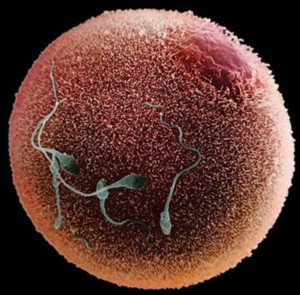What everyone should know
Most of us already know that an atom is the smallest division of matter that can take part in a chemical reaction; that a molecule is a structure of two or more atoms; and that life on Earth is based on organic molecules: defined as those molecules that contain carbon, often in combination with hydrogen, oxygen and nitrogen as well as other elements like sodium, calcium, phosphorous and iron.
Organic molecules can be very large indeed and come in all shapes and sizes. Like pieces in a jigsaw puzzle molecular shape is often important to an organic molecule's ability to bond to another to form elaborate and sometimes unique molecular structures.
All living things on Earth are comprised of cells and all cells are comprised of numerous molecular structures.
Unlike the 'ancients', most 'moderns' also know that each of us, like almost all animals and all mamals, originated from a single unique cell, an ova, that was contributed by our mother. This was fertilised by a single unique sperm from our father.
This 'fertilisation' triggered the first cell division. These two cells divided; and divided again and again; through gestation and on to birth childhood. So that by the time we are adults we've become a huge colony of approximately thirty seven thousand billion, variously specialised, cells of which between sixty and a hundred billion die and are replaced every day. Thus the principal function of a cell, over and above its other specialised purposes, is replication.
As a result, the mass of cells we lose each year, through normal cell division and death, is close to our entire body weight. Some cells last much longer than a year but few last longer than twenty years. So each of us is like a corporation in which every employee and even the general manager has changed, yet the institution goes on largely as before, thanks to a comprehensive list of job descriptions carried by every cell - our genome.
Cell replication is what we call 'life'. The replicating DNA molecule can therefore be regarded as the 'engine of life' or the 'life force' on Earth. So it is quite a good thing to understand.
What makes us human?
Different animals and plants have different numbers of genes and chromosomes that together make up their genome. Many are far more complex than humans. The 32 thousand human genes are organised into 23 pairs of chromosomes within each of our cells. But the protein-coding genes, that differentiate us, form only a fraction (about 1.5%) of the instruction and memory data that is stored in DNA. The remainder, coding for other aspects of cell chemistry, seems to be administrative overhead.
When human girls are born, they have about a million eggs in each of their two ovaries, nestled in fluid-filled cavities called follicles. But this number declines quite rapidly so that it is depleted by the time of menopause (usually before 50 years of age). Unless fertility treatment is in use, just one or sometimes two of these (apparently randomly selected) ova descends from the ovaries each menstrual period - down the woman's fallopian tubes where it (or they) may become fertilised if the woman has recently engaged in coitus (had 'sex').
As in vitro fertilization (IVF) demonstrates every day; we now understand that a unique version of your father's genome was injected into your mother's egg by just one of his millions of spermatozoa. So that when the two genomes merged a doubly unique cell, that became you, was the result.
Our genes, that are encoded in their DNA, come in equal proportion from both parents. Unless we have an identical twin, resulting from division of the zygote (see below) after fertilisation, each of us is genetically unique; our genetic identity determined by that successful fertilisation.
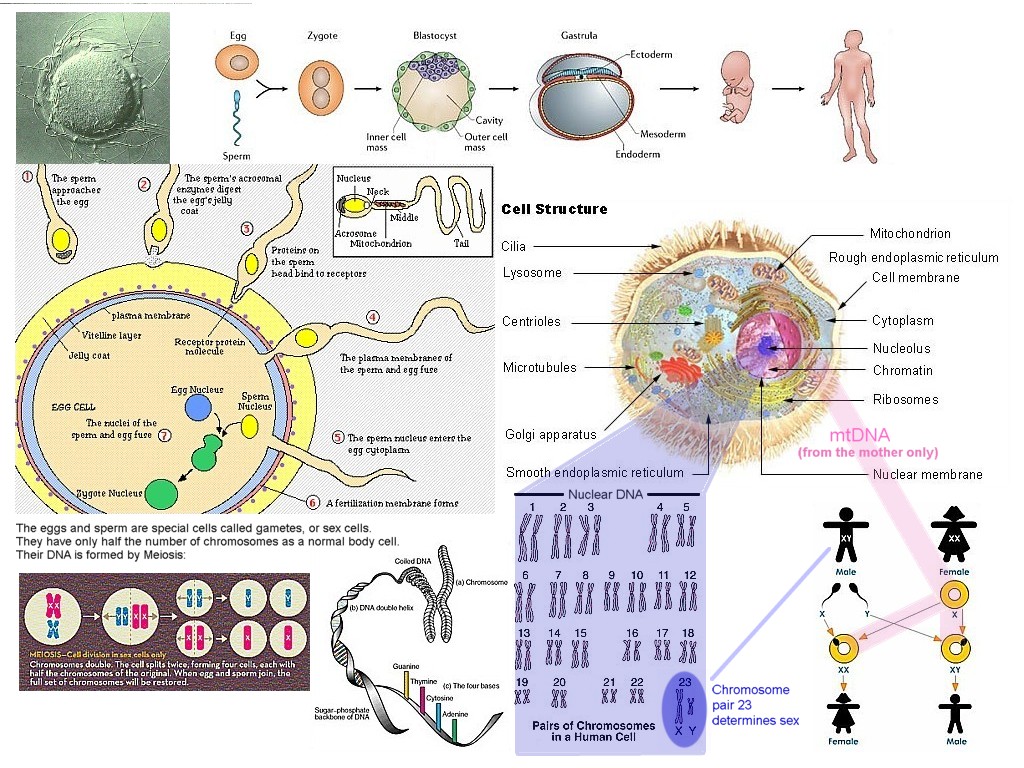
Human Reproduction - Click here to Expand
Within our species we are said to be of Caucasian or Asian or African appearance, to have dark or fair complexion and so on, and possibly to bear a ‘family resemblance’. These traits are due to the particular gene variants we have inherited from our parents.
These have been passed down to us, with regular variations, from parent to child, and through many ancestor species, since life began on the planet. And all plants and animals on Earth belong to a single family because we all inherit the same system of reproduction from one original replicating cell, our last universal common ancestor (LUCA) 3.5 to 3.8 billion years ago.
Replication
The DNA molecular structure resembles a zip fastener, where each tooth can be any of four molecular bases. The bases G-C and A-T are each small organic molecules that at one point are covalently bound to a triphosphate (containing three phosphorous atoms) and a sugar group that binds them in a ribbon. At their free end Guanine is attracted to Cytosine, with triple hydrogen bonds, and Adenine is attracted to Thymine, with double hydrogen bonds.
In the following notation: black = Carbon; blue = Nitrogen; red = Oxygen; white = Hydrogen. Bars joining them indicate a covalent bond, an electron shared between the atoms. A double bar indicates two shared electrons.
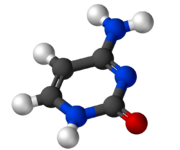 Cytosine (C4H5N3O) has a shape that attracts (fits)
Cytosine (C4H5N3O) has a shape that attracts (fits) 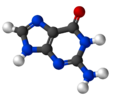 Guanine (C5H5N5O)
Guanine (C5H5N5O)
but not  Thymine (C5H6N2O2) or
Thymine (C5H6N2O2) or 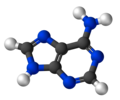 Adenine (C5H5N5), that attract (fit) each other.
Adenine (C5H5N5), that attract (fit) each other.
Each of these bases is bound to a ribbon of sugar molecules and at its other end lightly bonds to a matching base on the other half of the 'zipper' such that when it is 'unzipped' each attracts its opposite number (like magnets attracting the opposite pole) thus recreating a new matching half in the same sequence.
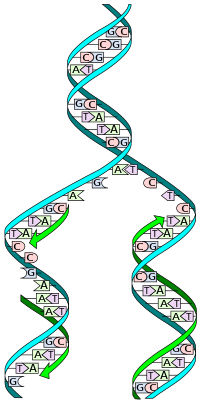
DNA replication.
This unzipping and reforming is called self-replication. It is going on continuously in all living things as new cells are created to replace those that die. In an adult human around three quarters of a million of our cells divide every second. This cell division is the process we call organic life and may continue (usually briefly) after we are legally (brain) dead.
Other chemical mechanisms within the cell translate the genetic information stored in the DNA sequence to manufacture the proteins from which new cells are built and differentiate themselves, organising to become our various organs and to thus arrange themselves to form a human; and not a gorilla or a crocodile or a kola or a rose or a cabbage. The human genome project had now identified 32,185 human genes.
Accurate reproduction is very important to the viability of an organism. Just as: 'WOLF' does not have the same meaning as 'FOWL' the location and order of sequence G-A-T-C within a particular DNA string (chromosome) will result in a different outcome to the sequence C-A-G-T . And this difference will influence cell structure and purpose: 'The wolf eats the fowl' has a totally different meaning to: 'The fowl eats the wolf'.
This method of storing and reproducing instructions and data is twice as efficient as the binary method we presently use in electronic devices. For example the binary processor in your computer or reading device requires each character in in each word in this sentence to be encoded in two bytes (each of 8 characters or bits). In other words 16 ones and zeros are required for every character on this page (eg 'a' = 0000000001100001) and a similar number for each pixel in a simple colour image. But DNA can encode the same information (sufficient for every unique character and symbol in every language in the world) in just eight characters.
There are a fraction over 3 billion characters in the human genome (3,079,843,747 base pairs). In computer terms this is equivalent to about three quarters of a gigabyte of information storage. The same data is stored in the nucleus of each of our cells. This is in nuclear DNA, before taking into account separate, but smaller, storage in each of the mitochondria (see below).
A 'gig' isn't much you might say (less than $1's worth) but the actual data storage density is in excess of anything offered by our present electronic technology. Cells are a lot smaller than the chip in a memory stick - there around a billion cells per cubic centimetre in hard tissue.
This also points to another reality. Had not this replication chemistry been available, and the conditions for the reactions been just right, life could not have occurred in its earthly form.
Life relying on another replication method that was say binary would be at a disadvantage and would have to use different replication mechanisms. If there was a chemistry, at different temperatures and chemical concentrations, allowing say six base pairs it would be different again. We and our cousins (the other animals, plants and other organisms) that are all descended from the original replicating cell (LUCA - see above) are here because the conditions on Earth were and are just right for our kind of life to prosper.
Elsewhere in the universe it may be different.
Gene Mapping
Genes are just patterns of chemical molecules that are held within the replicating DNA mechanism. The way they are encoded onto DNA can be likened to any other mechanism for copying and recording data: a DVD or even a vinyl record or the memory in this computer. As a result they can be altered or damaged from time to time and some of these variations are successfully copied into subsequent offspring. If they are particularly advantageous to survival and reproduction these changes, or mutations, rapidly spread throughout the species, so that over tens of thousands of years, individuals successful in one environmental niche are so different from those successful in another that a new species has formed (followed by a new genus, family, order, and so on).
This process of periodic differentiation has been likened to the branching of a tree but because of the activity of bacteria and viruses and residual DNA that may be reactivated as well as limited cross-species reproduction (for example later Humans and Neanderthal) it is no longer believed to be quite that simple.
DNA encodes the instructions for creating each cellular colony, defining each species, and each individual within a species. DNA changes over time in such away that each change is a development on previous generations. So it is possible to trace DNA ancestry back through generations of a particular species over time. For example, DNA studies are increasingly shedding light on the questions around human origins.
Most animals, including humans, carry two types of DNA. Our main genome is carried by the chromosomes in the nucleus of each of our cells. This comes from both our parents. The secondary genome, mtDNA, is carried by bacteria-like organelles within each of our cells, that convert sugars for cell energy, called mitochondria. These are all cloned (reproduced by asexual division) from the mitochondria that were within the original egg cell provided by our mother.
Cells may contain from one mitochondrion to several thousand mitochondria depending on species and cell differentiation. As a result this is the predominant DNA found in a cellular sample.
So our mtDNA comes only from our mother; in turn from her mother; and so on and mtDNA allows us to map the female ancestral line. This original egg cell was fertilised by a sperm from our father (sperm do not contribute their mitochondria). Once fertilised, the egg cell then divided repeatedly, differentiating in accordance with the coding instructions in our DNA, into the many cells that form the cellular colony that became 'us'.
Males are differentiated from females by a Y chromosome in place of one X. So sons can only inherit this from their father (like their family name in our culture) and periodic mutations in the DNA of the Y chromosome allow the (actual) male ancestral line to be traced back.
As a result of this work we now know that humans on the planet are all descended from a single group that left Africa less than 70 thousand years ago.
Recent DNA analysis shows that early humans sometimes interbred with the Neanderthal; a separate hominid subspecies that left Africa much earlier and settled in the Middle East and Europe over quarter of a million years ago.
It's amazing to think that we have only understood it within my lifetime. Now the ancient view that people grow from a seed, provided by their father, and gain the spark of life at 'conception' from a god is totally debunked. So throw away all those ancient texts.
Viruses
Viruses have been around since life began but they are 'of life', they are not technically 'alive' because they cannot themselves reproduce. They are extremely small - about 70 microns in diametre - and until the invention of electron microscopes in the 1930's their existance had only been inferred.
To create copies of themselves they need a host cell with the necessary reproductive mechanisms. Over the millennia viruses have evolved the necessary mechanisms to penetrate cells, much like spermatozoa, and inject their DNA or RNA and capture the host's replication mechanisms so that the infected cell begins manufacturing thousands of virion (virus particle) clones of the invader. These then capture other nearby cells in the host animal or plant; or in similar bacteria. Huge numbers of infected cells are usually destroyed in the process, sometimes killing the plant or animal.
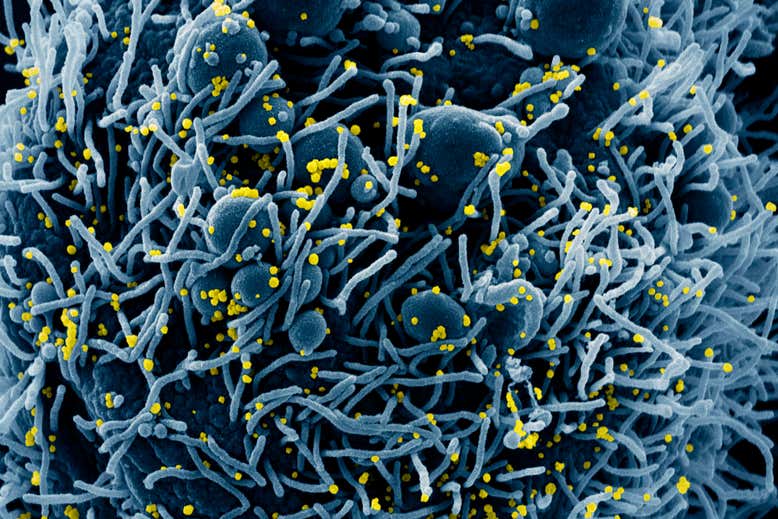
Coronavirus particles (yellow) on the surface of a dying cell (that produced them)
Niaid/National Institutes of Health/Science Photo Library (from https://www.newscientist.com)
But animals plants and bacteria have become familiar with this threat and have in turn evolved means of dealing with or living with viruses to the extent that some are exploited for the benefit of the host.
In turn viruses evolve new strategies to perpetuate their reproduction. Thus new viruses arise from time to time, sometimes jumping from one species to another when an opportunity arises.
Many animals, including humans, have an immune system that has a memory of harmful viruses and means of neutralising them. Thus, once the animal has been infected and survived, the chances of reinfection are reduced. Vaccines work by presenting our immune system with a harmless sample that allows it to recognise a particular harmful virus.
Since I first wrote this article the World has suffered a new viral pandemic. It is a novel corona virus for which we have no established immunity and there is no vaccine. At the end of June 2020 the Covi-19 virus has already killed half a million people.
It is estimated that this virus will no longer find sufficient vulnerable hosts to spread further after infecting around 70% of the populations in which it is spreading. It has a case fatality rate of just under 1%, that is, of those who catch it just under one in a hundred die.
Quarantine restrictions are in place in many countries to protect relatively uninfected areas, with local measures to eliminate 'hot spots'. But the majority of the world's population, in excess of five billion, are in countries in which it is presently spreading.
Unless a vaccine is available soon it seems inevitable that many millions more will be killed. The economic consequences are also dire.
